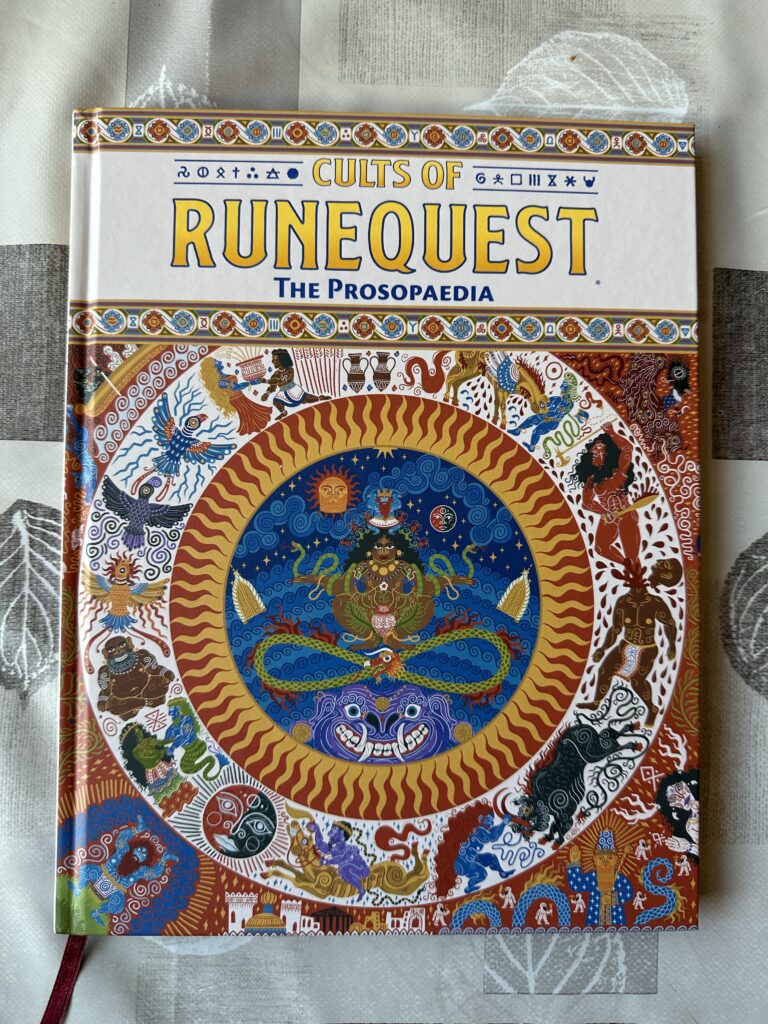
Chaosium’s Glorantha is known for being a fantasy world that can stand on its own. Some members of the fandom famously (and sometimes arguably unfortunately) “study” Glorantha as an almost academic pursuit, benefiting from the existence of almost as many system-less books on the topic as gaming books. In fact, two of the most acclaimed Glorantha books are system-less: the Glorantha Sourcebook (also here) won the ENnie gold medal for “Best Supplement” in 2019, and the massive encyclopedic two-volume Guide to Glorantha won, among other awards, the Diana Jones Award for Excellence in Gaming in 2015. Both of them have absolutely zero game mechanics in them.
This new release from Chaosium, The Prosopaedia, is another such system-less book, although arguably the first one to be branded under a game line (RuneQuest in this case). It is available in leatherette, hardcover, and PDF from Chaosium, and in PDF from DriveThruRPG. Let’s take a closer look!
The Cults of RuneQuest Line
The full name of this book is “Cults of RuneQuest: The Prospaedia“, and this is the first release in the “Cults of RuneQuest” product line. This line has had a rather, ahem, complicated history. If you’re interested in the context in which this new book is released, feel free to read this long section! If you just care about what’s in the book, skip to the next section!
Okay, still here? Let’s go.
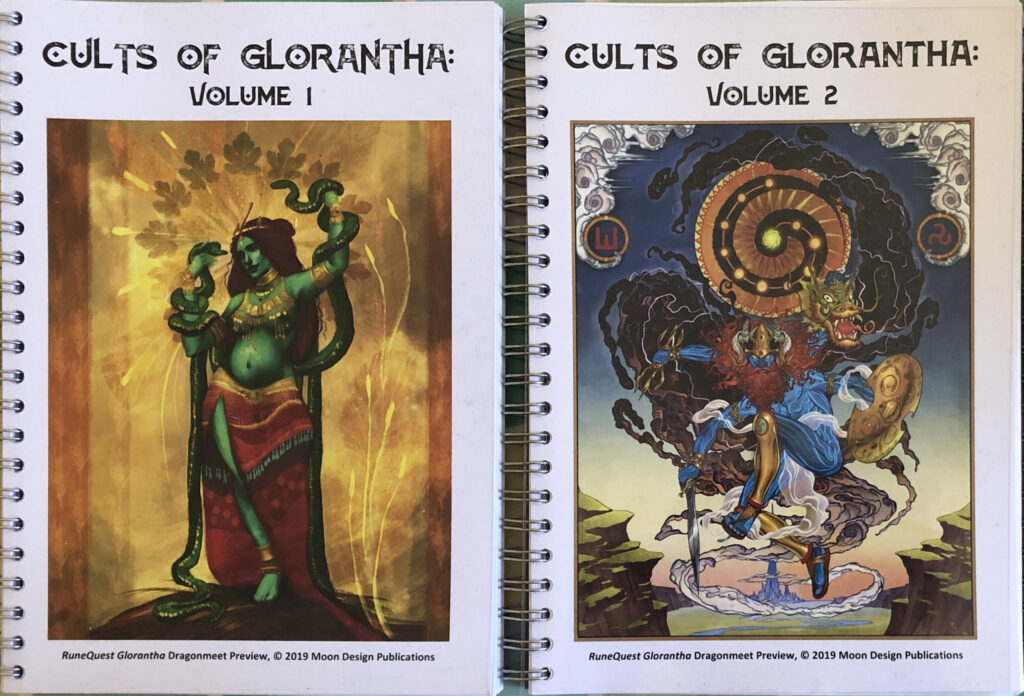
“Gods of Glorantha” (among other “work-in-progress” titles) was originally supposed to be released in 2021 or 2022 as a big slipcase set (comparable to Call of Cthulhu’s 2020 Malleus Monstrorum) after a preview manuscript was distributed at GenCon and other conventions in 2018 and 2019.
But with the passing of Greg Stafford in 2018, the beginning of the Covid pandemic in 2019, and the subsequent upheaval of the printing and shipping industries, plans changed. Then they changed again when the manuscript for Cults of Glorantha ballooned into a massive beast that wouldn’t fit any slipcase a human could carry. And then, maybe, they changed again when we suggested to Rick Meints that Chaosium could get “White Wolf rich” by releasing splatbooks for RuneQuest players1… well, that last one is entirely false (probably) but Chaosium still ended up splitting “Cults of Glorantha” into a line of splatbooks afterwards. That’s a good plan. They also renamed the line to “Cults of RuneQuest” in the process, possibly for brand awareness reasons. That’s less good in my opinion but hey, nobody should ask me for marketing advice anyway.
All these changes caused delays in the RuneQuest line and a problem for Chaosium: a lack of RuneQuest releases over the past two years and a half. The Red Book of Magic was released in late 2020, Weapons & Equipment in late 2021 (in PDF… the hardcover only arrived in mid-2022), and the Starter Set also in late 2021. The Starter Set (plus here) and Weapons & Equipment were generally hailed as good products in TTRPG review circles, but The Red Book of Magic was a bit more puzzling for reasons that might similarly cause people to be puzzled about the Prosopaedia. You see, while writing the massive Cults of Glorantha manuscript, the authors had to rely on a couple of reference documents to stay sane: one was a list of all the magic spells from all the cults featured in the manuscript, and the other was a list of all the gods known in Glorantha.
The first document of course became The Red Book of Magic. But, as Austin Conrad puts it in our recent episode, it looked like a box of cool toys without any instruction manual. That is: a list of cool magic spells without any information about which cults provide them. Cults of Glorantha was supposed to be released soon after, of course, but this never happened.
The second document became the Prosopaedia, which we are looking at right now. Like The Red Book of Magic, it is meant as a reference that complements the Cults of RuneQuest books. Unlike its predecessor, however, it clearly advertises itself as such:
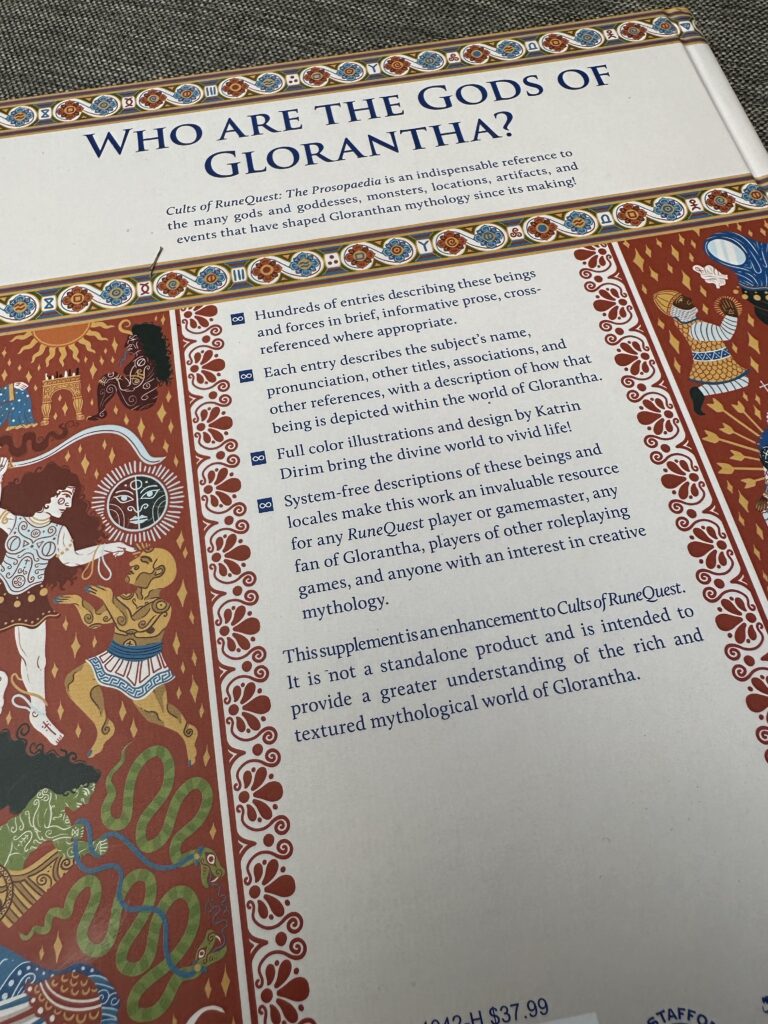
The back cover reads: “This supplement is an enhancement to Cults of RuneQuest. It is not a standalone product and is intended to provide a greater understanding of the rich and textured mythological world of Glorantha”.
So while Gloranthan scholars will of course jump on this book like a pack of rabid rubble runners on an adventurer’s calves2, the average RuneQuest player isn’t meant to read this in isolation… but that is of course what this book currently is: an isolated Cults of RuneQuest book, by virtue of it being the first release. This makes it a strange release, only explained by the fact that this Prosopaedia was supposed to be included in the original slipcase and was, therefore, ready for sales.
Whether it makes more sense to release it before or after the other books is hard to say until these other books are released, but there you go: the current situation is that RuneQuest players have had only 3 new releases in the last 30 months or so: a spell reference for books that aren’t out yet, a Starter Set mainly aimed at newcomers, and a list of equipment.
This is the context in which the Prosopaedia arrives. To say that RuneQuest fans are impatient for the following cult books is like saying that Harrek can sometimes get a little mean3. But the Prosopaedia isn’t quite the book that the fans are really waiting for. So we’ll take a look at it now, but keep in mind we might have to revisit it later, when we can actually use the Prosopaedia as intended: as a companion to the cults book.
The Proso-what?
As far as I can tell, the word “prosopaedia” is pretty much made up by Chaosium. I assume it is composed of “prosopon“, Greek for “face, mask, role, or person”, and “paideia“, which roughly means “education”, as in “encyclopedia”. So it’s an encyclopedia of “masks” and “roles”, a.k.a. an encyclopedia of deities. Disclaimer: I totally don’t know anything about Greek.
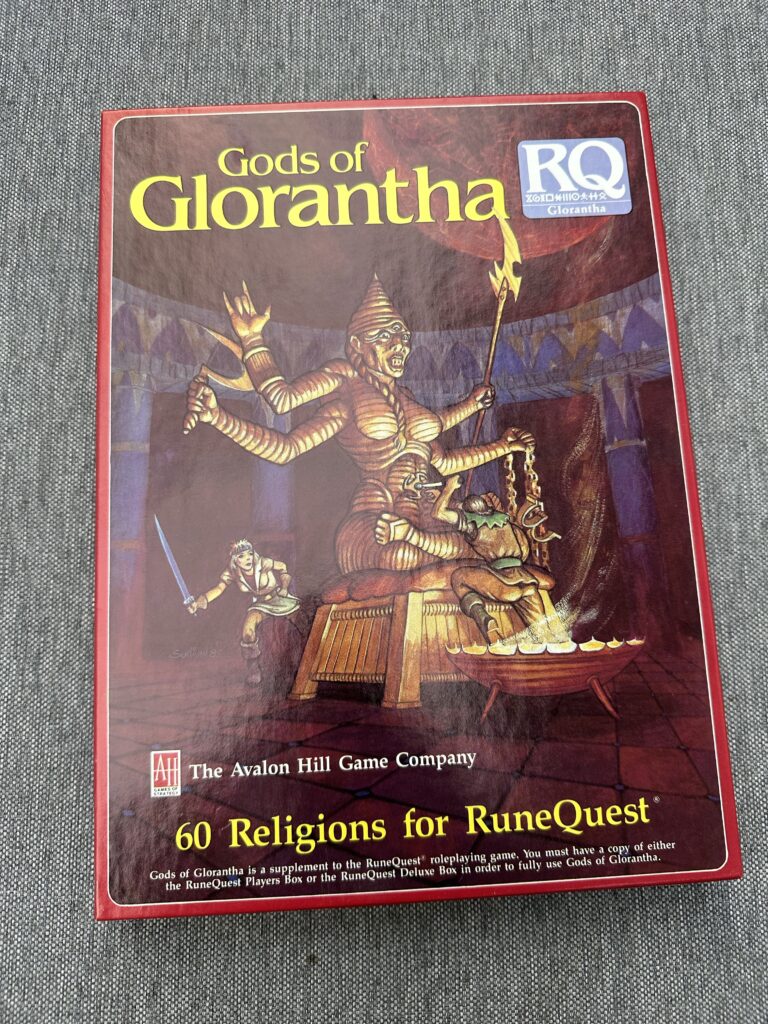
The first time Chaosium made a Prosopaedia was in the “Gods of Glorantha“, a boxed supplement for RuneQuest 3rd edition released in 1985. The Prosopaedia was one of the booklets found inside, with a couple dozen pages of short descriptions for many deities. Here it is, with a good boy for scale:
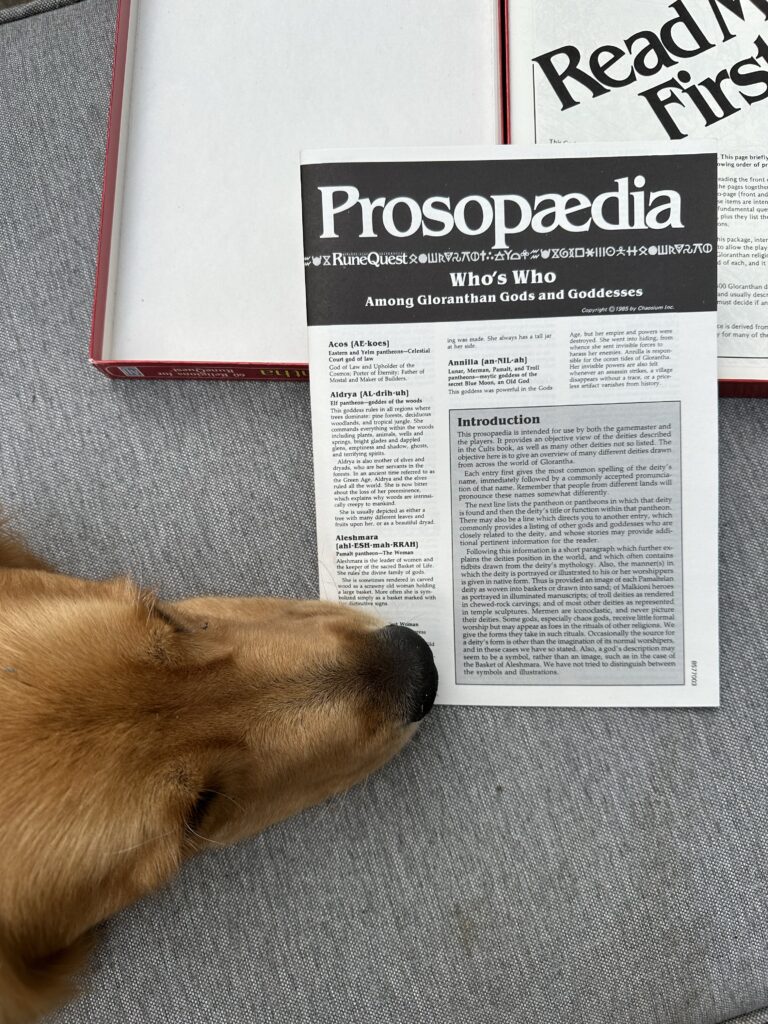
It contained an alphabetical list of Gloranthan deities each with a name, pantheon, title, pronunciation notes, and short description ranging from a short paragraph to a whole page column.
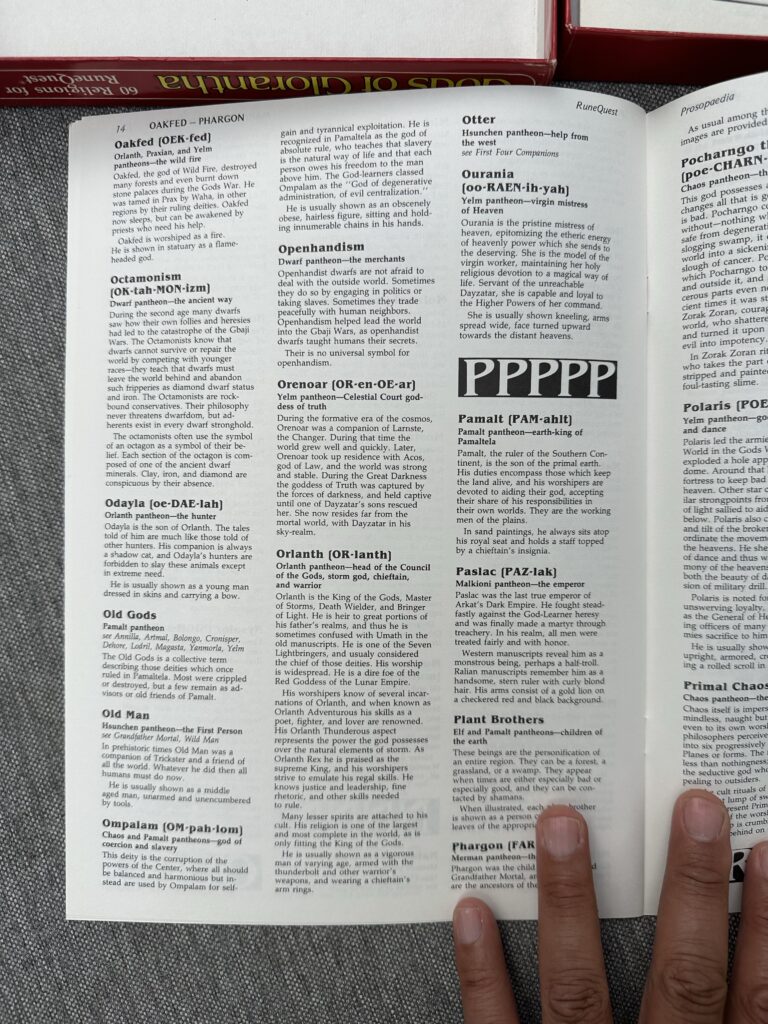
Revised Formula
The new Prosopaedia is of course much more exhaustive, clocking in at around 144 pages, but re-uses the same basic formula with a few additions.

First it’s got some wonderful illustrations, which we will talk about again soon. Second, a fair chunk of the deities get their Runes listed as well. Third, there are entries for other things than deities. The original Prosopaedia already had a few entries for non-deities, such as the Mostali heresies (individualism, openhandism, etc.) but there are many more in this new edition, such as heroes (e.g. Harrek, Jar-eel, Monrogh Lantern), landmarks (e.g. the Block, the Celestial River), concepts (e.g. God Time or, err, Colors) and more.
Sometimes it’s hard to figure out how the choices were made to include some things and not others. For instance, there are entries for the World Council of Friends and the God Learners, but none for the Empire of the Wyrms Friends4. I mean, as the God Learners ourselves, we totally support this selection, but you have to wonder. The EWF were worthy enemies and it’s sad to see them omitted like this.
Other times, you might end up having to switch between looking up something by its entry, or looking up something through the index at the end of the book (or via Ctrl+F if you’re using the PDF!) For example, the primordial mountain called the Spike is referenced through several entries (Acos, Krjalk, Magasta, etc), but doesn’t have an entry itself, while The Block (a piece of the Spike) does.
A few entries are similar or identical to the old Prosopaedia, but the vast majority of the text is new. Many entries already present in the old Prosopaedia have in fact been expanded or completely rewritten.
Art Fit For the Gods
The first thing to note about the Prosopaedia is the art. It is entirely done by the wonderful Katrin Dirim, recipient of the 2021 Greg Stafford Memorial Award for Gloranthan Fandom, and a guest on our podcast back when we talked about Earth cults. It’s actually hard these days to miss Katrin’s art in Gloranthan circles, since her extremely recognizable style has been featured in many Jonstown Compendium books (and more). But it’s great to see it here sprawled over an entire official Chaosium publication.

Katrin’s signature art really shines when it’s channelling the symbolism of the ancient world through a Gloranthan lens. Influences range from the Bronze and Iron Age Mediterranean to India, from the Ancient Near East to the Aztec, and probably many more that I’m not cultured enough to recognize.
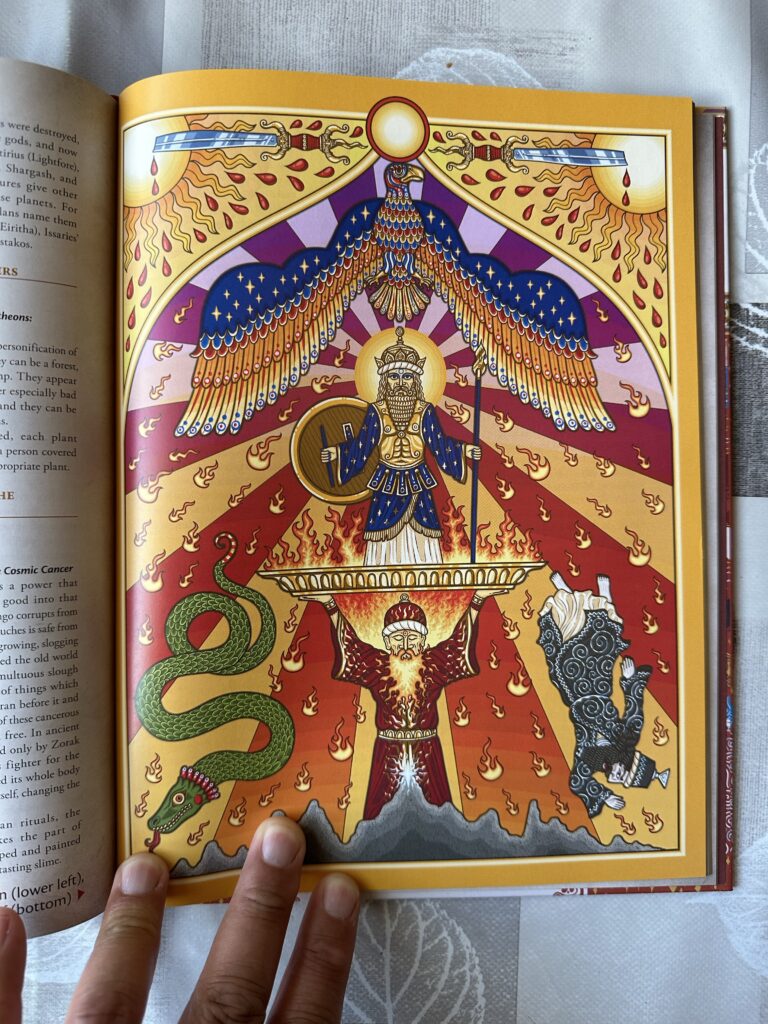
This brings a certain gravitas to the book. Another TTRPG publisher would have gone for cinematic paintings of gods in action poses, but here Chaosium hired Katrin to give us cultural depictions of these scenes, often with the precise detail and symbolism that Gloranthan scholars will pour over for hours. This is the kind of thing that sets RuneQuest apart from the other games, and the kind of aesthetic that makes Glorantha one of the very best fantasy worlds out there.
What Is It Good For?
So I’ve been writing about this book for several pages now and we still haven’t talked about its actual content. But the content is actually hard to evaluate.
On the one hand, we can find a lot of entries for commonly known deities, i.e. deities mentioned in the core RuneQuest rulebook and bestiary. But a lot of these deities and things are better described elsewhere. For instance, the Glorantha Sourcebook already provides explanations for the God Time or for Glorantha’s cosmology, descriptions of all the main gods, and more. Plus, these main gods will be obviously detailed in-depth in the upcoming Cults of RuneQuest books. So why buy the Proposopedia instead of one of these other books?
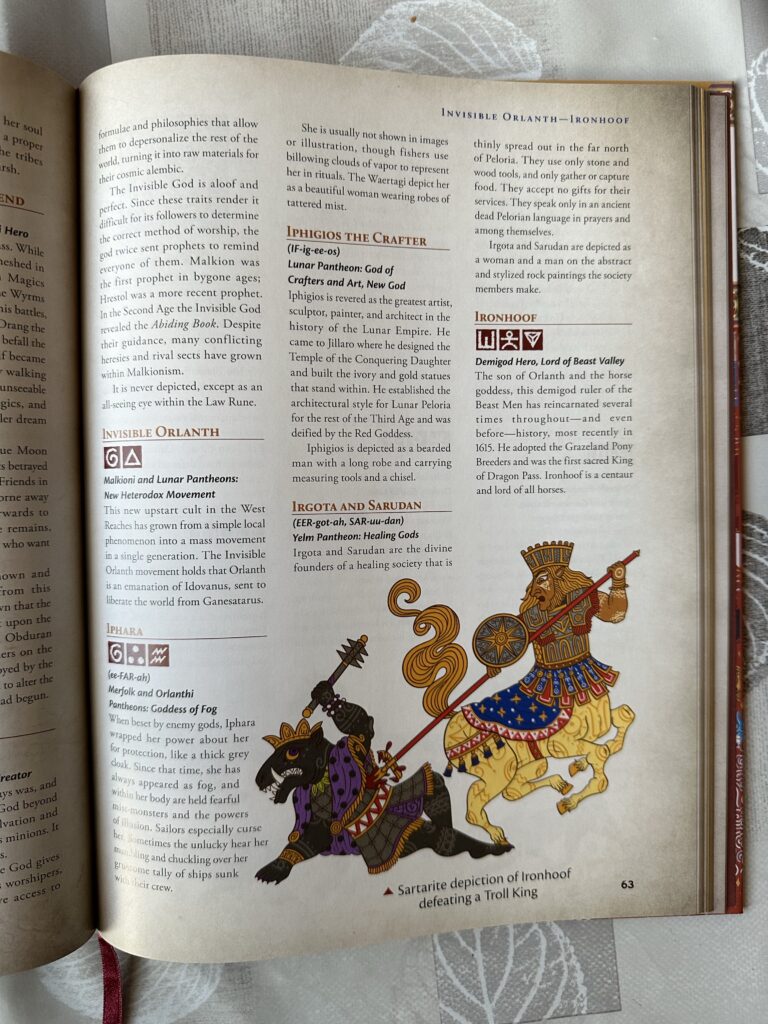
On the other hand, we can find even more entries for deities we might totally not even have heard of. This is especially true for deities of pantheons that aren’t much worshipped in Dragon Pass, such as the Lunar and Solar pantheons of Peloria, or the unique pantheons of the East Isles, Pamaltela, or Kralorela. These are places you might only know about if you have the Guide to Glorantha, for instance, in which case, well, you already have some short descriptions of these deities anyway. So again, why buy the Prosopaedia?
The answer lies in how everything in Glorantha is interconnected. Myths bounce off one another to form the vast tapestry of the Monomyth, events reverberate across the three Ages of Glorantha’s history, cult heroes channel strange aspects of their god, and dragons are found everywhere. If you want to make sense of these things or quickly check a single Proper Noun you forgot about, the Prosopaedia is probably your quickest printed reference. If you have spent more than 5 minutes looking through the index of the Glorantha Sourcebook or the Guide to Glorantha, or pressing F3 repeatedly through their PDFs, then you might find the Prosopaedia to be a more efficient entry point.
But as it says on the back cover, it is not a standalone product: it is an enhancement of the other books. So the fewer books you have, the less interesting the Prosopaedia might be to you. The more books you have, the more useful it might become because you have more chances to need to look up something.
Down The Rabbit Hole
One interesting use of the Prosopaedia is as a way to explore the interconnections of Glorantha and its Monomyth. That is: start with something we know and branch out into the unknown, uncovering hopefully new interesting entities and ideas. Does this sound like experimental heroquesting? Yes, it does! So instead of reading the book cover to cover like a giant bearded nerd, I tested whether we can shake something fun out of this book by hex-crawling through it as if it was a Fighting Fantasy novel written by Joseph Campbell5.
Starting with Orlanth
My first test started with something easy: Orlanth. Of course we get his Runes and fancy titles, and immediately get referred to “See Lightbringers, Ernalda“. After that we get two full columns of content.
Cool things we get here include:
- A bunch of nice alternative names for Orlanth. This is stuff we can use at the table: “I call on the Death Wielder to guide my hand in this battle!”
- The usual backstory and list of Orlanth’s main aspects and subcults, but in plain text, which makes it easy to understand the cosmic role of each archetype.
- A little bit about the constellation known as “Orlanth’s Ring”, which you might not know about if you don’t have the big system-less books.
- Many entries end with notes on how the current deity is usually depicted in art. Orlanth gets a fairly long paragraph for this, and this is immediately usable by the gamemaster to describe Orlanth temples, which is great.
Let’s branch out from that entry now. I went to his father Umath, his buddies the Lightbringers, Heler the God of Rain, and the Sky Dome in which “Orlanth’s Ring” lives. In about 10 minutes of flipping through the book, it led to this kind of thing:
- The Celestial Court and its old gods who created the Power and Elemental Runes (especially Harana Ilor, the creator of the Harmony Rune, “fashioned to resemble the strings of her magical harp”, and Ratslaff, the proto-Trickster, unintentional progenitor of creatures called “boggles”).
- Some nice description ideas for tribal re-enactments of the Lightbringers Quest, since each Lightbringer gets a few lines about how they’re usually depicted. Bonus points for Flesh Man, a crazed-looking person covered in funerary ashes.
- Arachne Solara intervened twice in Time to change the world, when Gbaji was born, and when the Jrusteli were punished… mmmh so if my players mess up big enough, I can bring giant spiders from outside Time. Good to know.
- Daga, the god of drought and famine, is imprisoned in a jar kept by Orlanth. Again there’s a couple options for depicting Daga, for when you inevitably unleash it on your players’ community.
- Priests of Heler might be loyal subordinates to their Orlanthi king… or their lover. Good to know too!
- The “Sky People”, of which the Sky Captains are part of, sometimes come down to Earth. Another cool idea for a scenario… although Austin Conrad has actually written that one already.
Again, all this information will probably be in the Orlanth cult write-up anyway, and in all the write-ups of the related cults… but it will probably take a lot longer than 10 minutes to cover this much ground when every write-up is 20 pages or more. Probably. Maybe? Again, it’ hard to tell how much better the Prosopaedia is at this kind of stuff until we know what the other books look like. But so far so good.
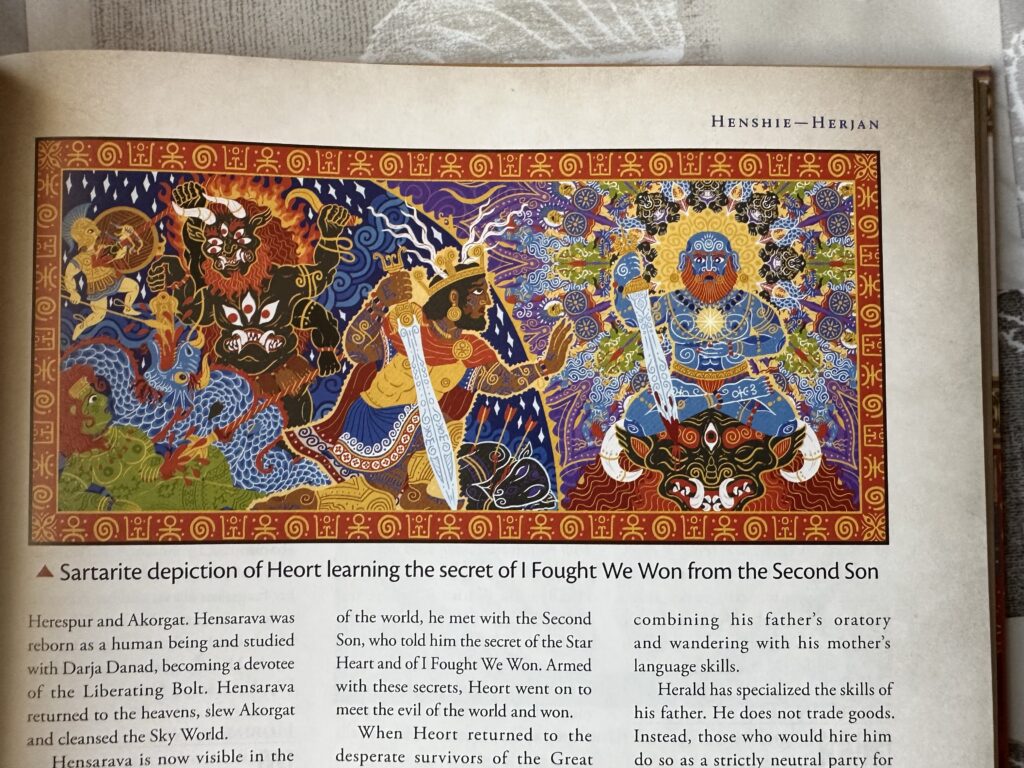
Starting with Chalana Arroy
Okay let’s try something else, and start with everybody’s favourite healer, Chalana Arroy.
- We encounter our first notable editing blunder in the book: Chalana Arroy’s entry tells us to “See Erissa“, but there is no entry for Erissa as far as I can tell. Editing mistakes are expected with a complex book like this, which contains hundreds of cross-referenced entries, but, well, here is one.
- Other editing problems crept up, as I realized that the few interesting things about Chalana Arroy are only accessible through a reverse search, and not by following the connections “forward”. For instance, there are entries for Zotulla (a subcult of Chalana Arroy found in Western Genertela), Arroin (Chalana Arroy’s son and patron of non-magical medicine), and the Sisters of Mercy (Chalana Arroy’s daughters and another subcult). This is interesting stuff, and all I’m missing now is the Lightbringers cult book so I can dive further into what these subcults do! But these entries reference Chalana Arroy, not the other way around. So you can’t get to them from the Chalana Arroy entry… you have to go hunt for them.
So this was OK, but not as useful as the previous dive given the limited number of connections and the editing issues.
Other Investigations
I’ll spare you my other test dives into the book, but they basically resulted in something in between these two tests.
- Sometimes you keep exploring for a long time, especially when something goes through the big names like Orlanth, Ernalda, Yelm, or the Red Goddess. We visit all of the highlights of Glorantha mythology that way. The main differences are that (1) it is highly summarized and edited down to just the most important bits, and (2) it is often written in a more factual, “out of character” way. So you might find it easier to get the gist of something through the Prosopaedia than through any other book.
- Sometimes an entry just doesn’t go very far, or doesn’t go anywhere at all. You kind of have to stumble upon it, so there definitely is value in flipping through the book and picking a page at random.
- Some entries form a closed circle, like the East Isles pantheon. This isn’t surprising, since they are also pretty much isolated in the setting itself. Again, there is value in stumbling upon them by picking things at random.
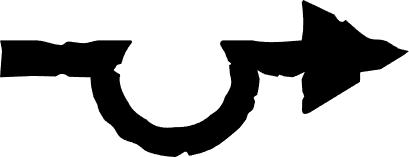
Conclusions
Prosopaedia is a wonderfully illustrated encyclopedia of the entire mythical landscape of Glorantha, a proof that RuneQuest isn’t like any other fantasy game, and a reference for obsessive Gloranthan dead tree lovers. If you ever come across a name like “La-Ungariant” and need to know what it refers to, if you ever need to remember who Issaries’ parents are, or if you ever visit Pamaltela and need some quick correspondence between the local deities and the Genertelan ones, the Prosopaedia will come to the rescue much faster than the Glorantha Sourcebook, the Guide to Glorantha, or, gods forbid, any Stafford Library obscurity.
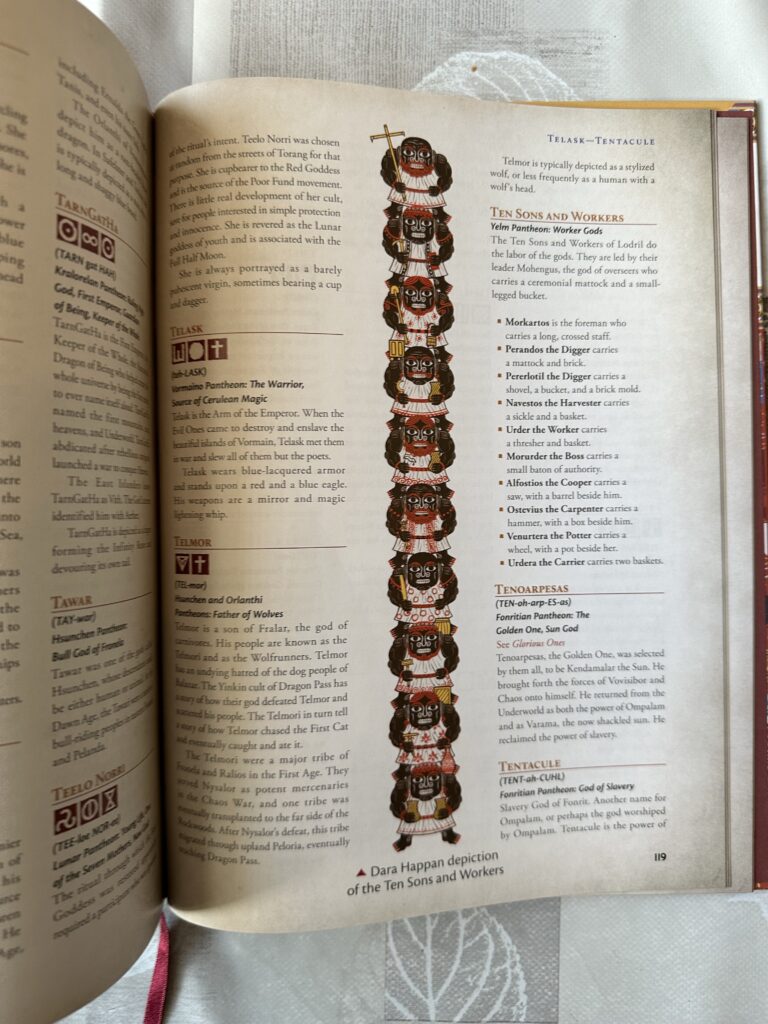
However, it’s hard to tell how useful the Prosopaedia is in practice, simply because, as mentioned previously, it’s meant to be a companion for books that aren’t released yet. And, as I said, you might find that the Prosopaedia‘s usefulness only grows with the number of other books you already own. But mostly, I can’t help thinking that it serves the same purpose as a real encyclopedia, if you can remember what that is. And who really does? For those of us who have spent most of their lives with Wikipedia, it’s a bit weird to rely on a fixed, printed knowledge base. There’s a reason my co-host Joerg went with a digital database to help his Gloranthan studies years ago. The whole point of Wikipedia and other wikis is that each entry can be improved over time with better content and cross-referencing, and that exploring the connections between topics is as simple as a click… David Scott (possibly assisted by a few volunteers) has been maintaining an online Prosopaedia on the Well of Daliath that is well worth checking out, and frankly I suspect that sticking the Prosopaedia‘s text and art up there (or on the RuneQuest wiki) would be more efficient. Problems like, say, the lack of connections between the Chalana Arroy topics would be fixed rather quickly. The vast tapestry of Glorantha’s Monomyth would get incrementally easier to grasp and navigate. This is what online resources are good at.
But I can already hear the old-school RuneQuest players shaking their fist at me. Some of them already can’t stand PDFs, so I can only imagine what they’d say about an online RuneQuest release. It’s not even clear how Chaosium would get money for that kind of thing, short of doing some sort of digital subscription, the kind that gets everybody mad at Wizards of the Coast. Maybe there will eventually be an online Prosopaedia sold as a VTT module, who knows.
Still, the Prosopaedia as a book is fun to flip through. I enjoy picking pages at random to see what’s there and, hopefully, get some fun idea for my game. Sometimes the idea is right there on the page, and sometimes it sends me to other books to further research a topic. In this sense, the Prosopaedia has already been helpful in a couple of occasions, like that time my players ran into a forgotten half-temple to Caladra & Aurelion, hidden under the city of Solung. Fun things happened… and yes, the rubble runners went for my players’ calves.
1 White Wolf famously released many “splatbooks” for their smash-hit game Vampire: The Masquerade in the late 1990s. Vampires generally belonged to “clans” which each had their own vibe and powers, a bit like RuneQuest cults. Each splatbook was dedicated to a single clan, with backstory, new powers, NPCs, and so on. At least, RuneQuest is grouping up cults instead of releasing one book per cult!
2 I had forgotten that Rubble Runners can stay attached once they successfully bite someone, dealing damage every round… this is explained in the RuneQuest Bestiary of course but I don’t like looking at stat blocks for too long, it gives me a headache. But thank you to my players for reminding me!
3 Harrek is a Gloranthan “super hero”. He killed a bear god and wears its pelt as a cloak. He killed the Red Emperor. He regularly plunders cities with his fleet of Wolf Pirates. You don’t fuck with him.
4 These are all First Age and Second Age empires. The World Council of Friends was basically the United Nations for Glorantha in the couple centuries following the Dawn and the beginning of Time. Everybody was buddies. It didn’t end very well. The God Learners and the Empire of the Wyrms Friends were two big empires of the Second Age that, together, ruled over most of Glorantha. The former (us) were min-maxing scholars who tried to milk the God Time for everything it’s got. The latter (our enemies) were dragon-loving weirdoes who tried to transform the world into a giant cosmic dragon. It didn’t end very well either.
5 I hope you know what Fighting Fantasy books are. If not, go pick one! Or any other “Choose Your Own Adventure” book, really. They’re fun! Well at least they were when I was 10 years old. On the other hand Joseph Campbell is a lot less fun. He’s the guy who coined the concept of the “monomyth”, and theorized that all of Earth’s myth are sort of telling the same story. It’s nice to design a fantasy world. It’s less nice when glossing over people’s cultures.


“We encounter our first notable editing blunder in the book: Chalana Arroy’s entry tells us to “See Erissa“, but there is no entry for Erissa as far as I can tell.”
And if someone had put *links* in the PDF for all those cross-references, perhaps it would have been caught. Ho hum!
I just wanted to thank you for all that you do. You are my favorite Glorantha writer. When you distill concepts and information into “The World Council of Friends was basically the United Nations for Glorantha” and “Arkat was the fist Min/Maxer”, It motivates me to not give up on this massively complex world. I wish more authors would do the same. Thanks again.
Thanks, that’s very much appreciated because we indeed try to make Glorantha accessible! Cheers!
Hi! It’s been some time and some other cults books have already been published. What are your thoughts about the utility of the Prosopaedia in conjunction with The Lightbringers, The Earth Goddesses and The Lunar Way? (And Mythology as well). Thanks!
Hi! I’d say the Prosopaedia is a reference book that is useful when doing research for writing a scenario, or as a quick reference at the table for when something comes up. Probably not as widely useful as the Cults books, which players can directly benefit from, though.